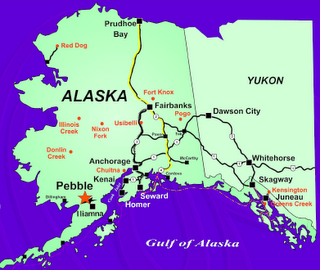 The proposed Pebble Mine in Alaska is a mineral exploration project investigating a very large copper, gold and molybdenum mineral deposit in the Bristol Bay region of Southwest Alaska. The proposal to mine the ore deposit, using large-scale operations and infrastructure, is controversial. The proposed Pebble mine would be the largest open-pit mine ever constructed in North America. Its massive footprint—including a 1300-acre mining pit, a 3,600-acre tailings impoundment and a 685-foot-high earthen dam—lies across the headwaters of the two most productive salmon-bearing rivers in Bristol Bay. The salmon-bearing rivers in Bristol Bay headwaters are an essential nursery for healthy salmon populations.
The proposed Pebble Mine in Alaska is a mineral exploration project investigating a very large copper, gold and molybdenum mineral deposit in the Bristol Bay region of Southwest Alaska. The proposal to mine the ore deposit, using large-scale operations and infrastructure, is controversial. The proposed Pebble mine would be the largest open-pit mine ever constructed in North America. Its massive footprint—including a 1300-acre mining pit, a 3,600-acre tailings impoundment and a 685-foot-high earthen dam—lies across the headwaters of the two most productive salmon-bearing rivers in Bristol Bay. The salmon-bearing rivers in Bristol Bay headwaters are an essential nursery for healthy salmon populations. Proponents argue that the mine will create jobs, provide tax revenue to the state of Alaska, and reduce American dependence on foreign sources of raw materials. Pebble proponents question the EPA's right to deny permits before submitting an application.
Opponents argue that the mine would adversely affect the entire Bristol Bay watershed; and that the possible consequences to fish populations, when mining effluents escape planned containments, are simply too great to risk. Much of this debate concerns the tentative plan to impound large amounts of water, waste rock, and mine tailings behind several earthen dams at the mine site. Opponents believe the Pebble project mine's hundreds of jobs pale in comparison to the 14,000 current jobs tied to the sustainable Bristol Bay salmon fishery, an industry that requires a healthy habitat: basically swapping 14,000 fishing jobs for 1,000 mining jobs. (Wiki, WSJ, 10/29/2012)













0 comments:
Post a Comment